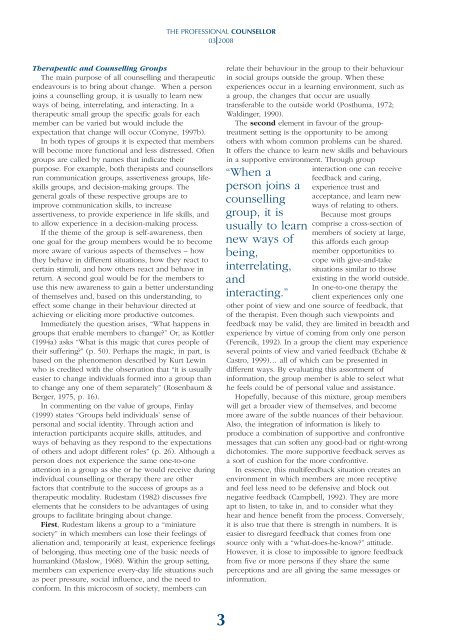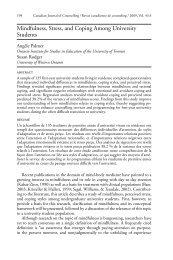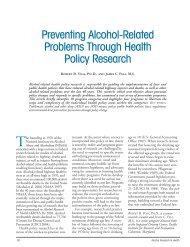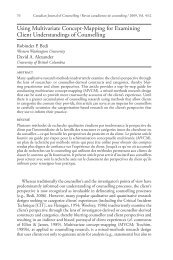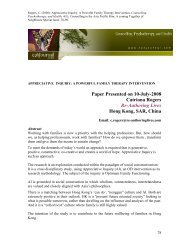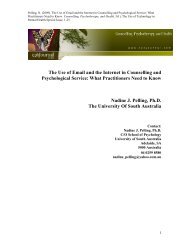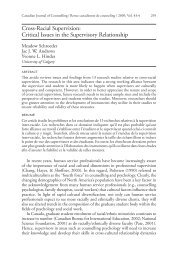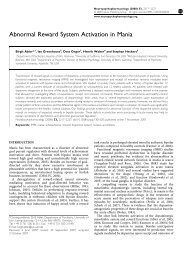PROFESSIONAL COUNSELLOR - Mental Health Academy
PROFESSIONAL COUNSELLOR - Mental Health Academy
PROFESSIONAL COUNSELLOR - Mental Health Academy
Create successful ePaper yourself
Turn your PDF publications into a flip-book with our unique Google optimized e-Paper software.
THE <strong>PROFESSIONAL</strong> <strong>COUNSELLOR</strong><br />
03 2008<br />
Therapeutic and Counselling Groups<br />
The main purpose of all counselling and therapeutic<br />
endeavours is to bring about change. When a person<br />
joins a counselling group, it is usually to learn new<br />
ways of being, interrelating, and interacting. In a<br />
therapeutic small group the specific goals for each<br />
member can be varied but would include the<br />
expectation that change will occur (Conyne, 1997b).<br />
In both types of groups it is expected that members<br />
will become more functional and less distressed. Often<br />
groups are called by names that indicate their<br />
purpose. For example, both therapists and counsellors<br />
run communication groups, assertiveness groups, lifeskills<br />
groups, and decision-making groups. The<br />
general goals of these respective groups are to<br />
improve communication skills, to increase<br />
assertiveness, to provide experience in life skills, and<br />
to allow experience in a decision-making process.<br />
If the theme of the group is self-awareness, then<br />
one goal for the group members would be to become<br />
more aware of various aspects of themselves – how<br />
they behave in different situations, how they react to<br />
certain stimuli, and how others react and behave in<br />
return. A second goal would be for the members to<br />
use this new awareness to gain a better understanding<br />
of themselves and, based on this understanding, to<br />
effect some change in their behaviour directed at<br />
achieving or eliciting more productive outcomes.<br />
Immediately the question arises, “What happens in<br />
groups that enable members to change” Or, as Kottler<br />
(1994a) asks “What is this magic that cures people of<br />
their suffering” (p. 50). Perhaps the magic, in part, is<br />
based on the phenomenon described by Kurt Lewin<br />
who is credited with the observation that “it is usually<br />
easier to change individuals formed into a group than<br />
to change any one of them separately” (Rosenbaum &<br />
Berger, 1975, p. 16).<br />
In commenting on the value of groups, Finlay<br />
(1999) states “Groups held individuals’ sense of<br />
personal and social identity. Through action and<br />
interaction participants acquire skills, attitudes, and<br />
ways of behaving as they respond to the expectations<br />
of others and adopt different roles” (p. 26). Although a<br />
person does not experience the same one-to-one<br />
attention in a group as she or he would receive during<br />
individual counselling or therapy there are other<br />
factors that contribute to the success of groups as a<br />
therapeutic modality. Rudestam (1982) discusses five<br />
elements that he considers to be advantages of using<br />
groups to facilitate bringing about change.<br />
First, Rudestam likens a group to a “miniature<br />
society” in which members can lose their feelings of<br />
alienation and, temporarily at least, experience feelings<br />
of belonging, thus meeting one of the basic needs of<br />
humankind (Maslow, 1968). Within the group setting,<br />
members can experience every-day life situations such<br />
as peer pressure, social influence, and the need to<br />
conform. In this microcosm of society, members can<br />
relate their behaviour in the group to their behaviour<br />
in social groups outside the group. When these<br />
experiences occur in a learning environment, such as<br />
a group, the changes that occur are usually<br />
transferable to the outside world (Posthuma, 1972;<br />
Waldinger, 1990).<br />
The second element in favour of the grouptreatment<br />
setting is the opportunity to be among<br />
others with whom common problems can be shared.<br />
It offers the chance to learn new skills and behaviours<br />
in a supportive environment. Through group<br />
“When a<br />
person joins a<br />
counselling<br />
group, it is<br />
usually to learn<br />
new ways of<br />
being,<br />
interrelating,<br />
and<br />
interacting.”<br />
interaction one can receive<br />
feedback and caring,<br />
experience trust and<br />
acceptance, and learn new<br />
ways of relating to others.<br />
Because most groups<br />
comprise a cross-section of<br />
members of society at large,<br />
this affords each group<br />
member opportunities to<br />
cope with give-and-take<br />
situations similar to those<br />
existing in the world outside.<br />
In one-to-one therapy the<br />
client experiences only one<br />
other point of view and one source of feedback, that<br />
of the therapist. Even though such viewpoints and<br />
feedback may be valid, they are limited in breadth and<br />
experience by virtue of coming from only one person<br />
(Ferencik, 1992). In a group the client may experience<br />
several points of view and varied feedback (Echabe &<br />
Castro, 1999)… all of which can be presented in<br />
different ways. By evaluating this assortment of<br />
information, the group member is able to select what<br />
he feels could be of personal value and assistance.<br />
Hopefully, because of this mixture, group members<br />
will get a broader view of themselves, and become<br />
more aware of the subtle nuances of their behaviour.<br />
Also, the integration of information is likely to<br />
produce a combination of supportive and confrontive<br />
messages that can soften any good-bad or right-wrong<br />
dichotomies. The more supportive feedback serves as<br />
a sort of cushion for the more confrontive.<br />
In essence, this multifeedback situation creates an<br />
environment in which members are more receptive<br />
and feel less need to be defensive and block out<br />
negative feedback (Campbell, 1992). They are more<br />
apt to listen, to take in, and to consider what they<br />
hear and hence benefit from the process. Conversely,<br />
it is also true that there is strength in numbers. It is<br />
easier to disregard feedback that comes from one<br />
source only with a “what-does-he-know” attitude.<br />
However, it is close to impossible to ignore feedback<br />
from five or more persons if they share the same<br />
perceptions and are all giving the same messages or<br />
information.<br />
3


